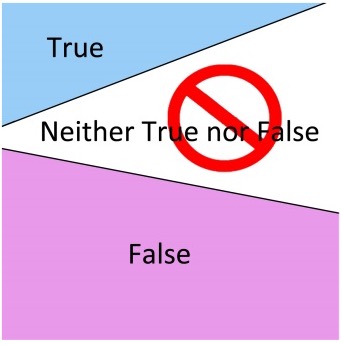Subsection 3.5.3 Law of the Excluded Middle
Most of the premises that you’ll use in your proofs will be ones that you’ve chosen to correspond to things that are true in the problem domain you’re working in. There is one premise, though, that we’ll mention here because it’s very general and is not infrequently useful. It is:
Law of the Excluded Middle : p ∨ ¬ p .
In other words, for any statement p , either it’s true or false. Either it or its negation must be true. There’s nothing “in the middle”.
Notice, by the way, that p ∨ ¬ p is a tautology. It’s always true. (That’s why it’s always a safe premise.) We’ve chosen to exhibit it here and give it a name because it actually comes up in arguments. We’ve used it a few times already in this course. But, in fact, it’s always safe to use as a premise any tautology. Such a premise will never make it possible to prove something that wasn’t provable (perhaps less directly) some other way.
Nifty Aside:The Law of the Excluded Middle is noncontroversial in Boolean logic. It’s a tautology. But we should point out that, when we move on to predicate (quantified) logic, there are approaches that do not take it as an axiom. We will. But you should know that not everyone does.
English AsideWhen we’re talking in English, rather than writing in logic, it is frequently less obvious that the Law of the Excluded Middle applies. There are many reasons for this including:
Many concepts are fuzzy. It’s generally quite clear what a cat is. So if we let C stand for the claim that Lucy is a cat, we probably won’t get in trouble when we try to assign it a truth value (T or F). But now suppose that Brett is 11 months old. Is it true or false that Brett is a baby? Maybe baby is right. Or maybe a toddler, but not a baby. A person might say, “Sort of”.
Recall that a presupposition is something that a speaker assumes to be true but doesn’t explicitly mention. When presuppositions are false, it’s hard to assign any truth value. Should we assign T or F to, “The king of France has red hair”? (Exactly who is “the king of France?”)
“Not” can do many different things in English. Consider the sentence, “Travis likes Jody”. To negate that in an unambiguous way, we’d have to say, “It’s not the case that Travis likes Jody.” If we do that, then one or the other of the sentences is true (although even here we could be in trouble if Travis admits to having a lot of conflicting feelings about Jody.) But sentences like our second one are rare. We’d be much more likely to say, “Travis doesn’t like Jody”, which is likely to be interpreted as, “Travis dislikes Jody”. But now it could easily happen that neither “Travis likes Jody,” nor “Travis dislikes Jody,” is true. It’s possible that Travis doesn’t know Jody and has no opinion about her. Yet both of these sentences assert that Travis does have some opinion. So they could both be false.
We’ll have more to say about these issues later, when we talk about the complex ways in which English sentences map to logical ones. For now, however, we’ll take the Law of the Excluded middle as a premise.

